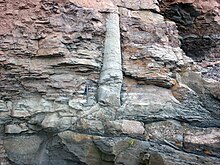Stigmaria: Difference between revisions
No edit summary |
Fixing errors and rewriting article, removing no citations tag. |
||
| Line 1: | Line 1: | ||
{{italic title}} |
|||
{{Unreferenced|date=December 2009}} |
|||
[[Image:Lepido root top.jpg|thumb|''Stigmaria'', a fossil lycopsid [[rhizome]].]] |
[[Image:Lepido root top.jpg|thumb|''Stigmaria'', a fossil lycopsid [[rhizome]].]] |
||
[[Image:Lycopsid joggins mcr1.JPG|thumb|''In situ'' [[lycopsid]] with attached stigmarian roots. Joggins Formation ([[Pennsylvanian (geology)|Pennsylvanian]]), Cumberland Basin, Nova Scotia.]] |
[[Image:Lycopsid joggins mcr1.JPG|thumb|''In situ'' [[lycopsid]] with attached stigmarian roots. Joggins Formation ([[Pennsylvanian (geology)|Pennsylvanian]]), Cumberland Basin, Nova Scotia.]] |
||
[[Image:Stigmaria mcr1.jpg|thumb|Bedding plane view of a flattened ''Stigmaria'' preserved atop a shallow-water carbonaceous limestone in the Joggins Formation ([[Pennsylvanian (geology)|Pennsylvanian]]), Cumberland Basin, Nova Scotia.]] |
[[Image:Stigmaria mcr1.jpg|thumb|Bedding plane view of a flattened ''Stigmaria'' preserved atop a shallow-water carbonaceous limestone in the Joggins Formation ([[Pennsylvanian (geology)|Pennsylvanian]]), Cumberland Basin, Nova Scotia.]] |
||
'''''Stigmaria''''' is a [[form taxon (botany)|form taxon]], for common fossils found in [[Carboniferous]] rocks.<ref name="Rothwell">{{cite journal|last1=Rothwell|first1=GW|last2=Erwin|first2=DM|title=The rhizophore apex of Paurodendron: implications for homologies among the rooting organs of Lycopsida|journal=American Journal of Botany|date=1985|volume=72|pages=86-98}}</ref> They represent the underground rooting structures of [[coal forest]] [[lycopsid]] trees such as ''[[Sigillaria]]'' and ''[[Lepidodendron]]''. These swamp forest trees grew to 50 meters and were anchored by an extensive network of branching underground structures with "rootlets" attached to them. Analysis of the morphology and anatomy of these stigmarian systems suggests they are shoot-like and so they are called rhizomes or rhizophores. The stigmarian rhizomes are typically covered with a spiral pattern of circular scars where "rootlets" were attached. Since the stigmarian systems are shoot-like, these "rootlets" may be modified leaves, adapted to serve the function of roots. However, some paleontologists argue that the "rootlets" were true roots, with a complex branching structure and root hairs, comparable to the roots of the closest living relative of ''Lepidodendron'', the quillworts (genius ''[[Isoetes]]''.<ref name="Hetherington">{{cite journal|last1=Hetherington|first1=AJ|last2=Berry|first2=CM|last3=Dolan|first3=Liam|title=Networks of highly branched stigmarian rootlets developed on the first giant trees|journal=PNAS|date=June 14, 2016|volume=113|issue=24|pages=6695–6700|doi=www.pnas.org/cgi/doi/10.1073/pnas.1514427113|url=http://www.pnas.org/content/113/24/6695.full.pdf?with-ds=yes|accessdate=15 February 2017}}</ref> |
|||
'''''Stigmaria''''' are a type of branching tree root fossil found in [[Carboniferous]] rocks. They were the roots of [[coal forest]] [[lycopsid]] trees such as ''[[Sigillaria]]'' and ''[[Lepidodendron]]''. Each trunk tended to have four of those roots. ''Stigmaria'' is a [[form taxon (botany)|form taxon]], as the genus and species of the plant bearing the root is not identified. |
|||
[[Category:Carboniferous plants]] |
[[Category:Carboniferous plants]] |
||
Revision as of 17:44, 15 February 2017



Stigmaria is a form taxon, for common fossils found in Carboniferous rocks.[1] They represent the underground rooting structures of coal forest lycopsid trees such as Sigillaria and Lepidodendron. These swamp forest trees grew to 50 meters and were anchored by an extensive network of branching underground structures with "rootlets" attached to them. Analysis of the morphology and anatomy of these stigmarian systems suggests they are shoot-like and so they are called rhizomes or rhizophores. The stigmarian rhizomes are typically covered with a spiral pattern of circular scars where "rootlets" were attached. Since the stigmarian systems are shoot-like, these "rootlets" may be modified leaves, adapted to serve the function of roots. However, some paleontologists argue that the "rootlets" were true roots, with a complex branching structure and root hairs, comparable to the roots of the closest living relative of Lepidodendron, the quillworts (genius Isoetes.[2]
- ^ Rothwell, GW; Erwin, DM (1985). "The rhizophore apex of Paurodendron: implications for homologies among the rooting organs of Lycopsida". American Journal of Botany. 72: 86–98.
- ^ Hetherington, AJ; Berry, CM; Dolan, Liam (June 14, 2016). "Networks of highly branched stigmarian rootlets developed on the first giant trees" (PDF). PNAS. 113 (24): 6695–6700. doi:www.pnas.org/cgi/doi/10.1073/pnas.1514427113. Retrieved 15 February 2017.
{{cite journal}}: Check|doi=value (help)
